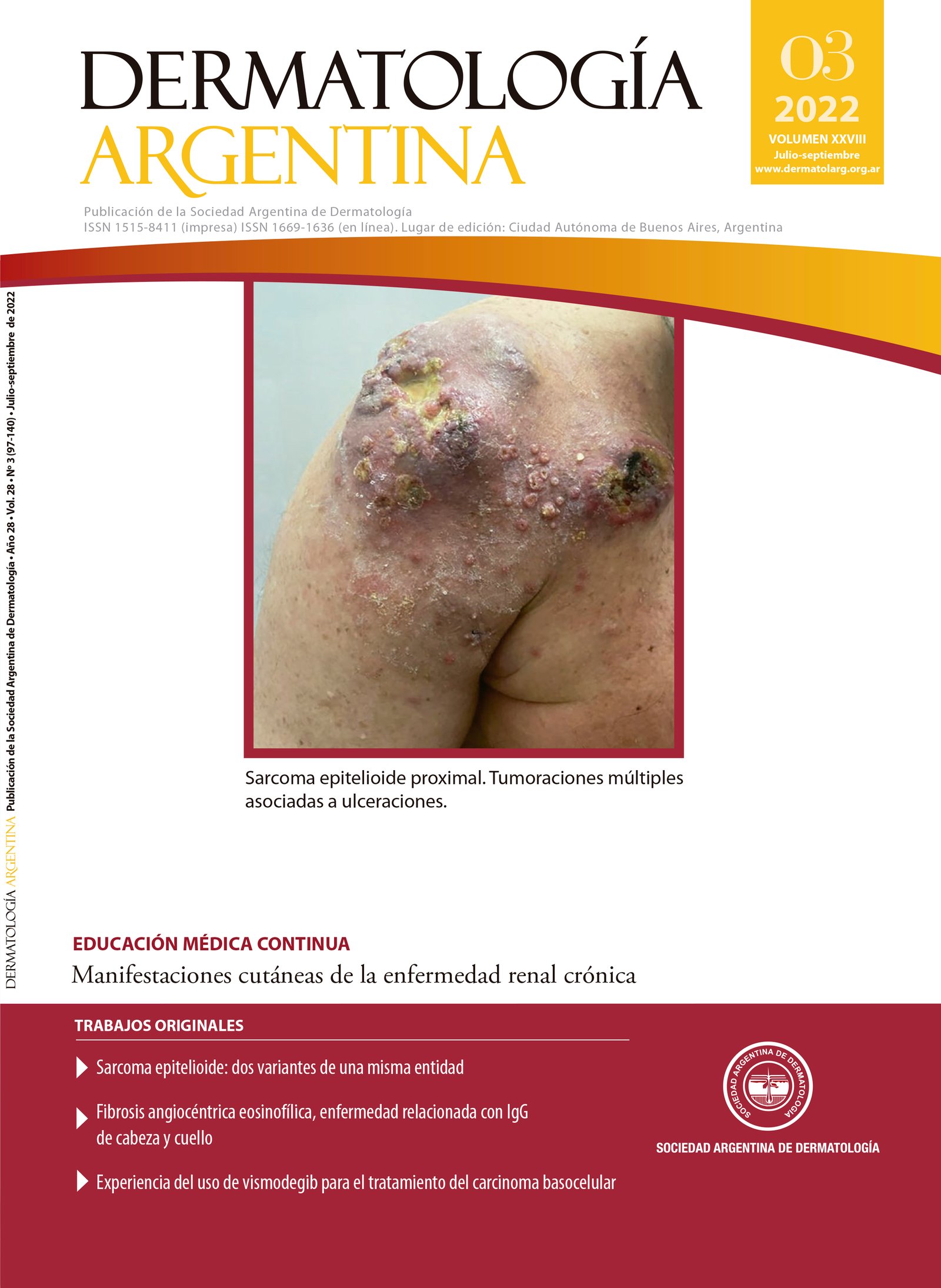Experiencia del uso de vismodegib para el tratamiento del carcinoma basocelular
Palabras clave:
carcinoma basocelular, cáncer cutáneo no melanoma, tumores queratinocíticos, vismodegib, inhibidores sonic hedgehogResumen
El tratamiento de los carcinomas basocelulares localmente invasores, metastásicos o inoperables representa un desafío. Las opciones terapéuticas son limitadas y su elección depende de múltiples factores. En 2012, la Food and Drug Administration (FDA) aprobó el vismodegib, un inhibidor sistémico de la vía hedgehog, indicado especialmente para estos pacientes. Presentamos en la siguiente serie 9 casos tratados con el vismodegib, con la intención de dar a conocer nuestra experiencia. Describimos, en cada paciente, las características clinicopatológicas del tumor, la duración del tratamiento, su evolución y los efectos adversos.
Citas
I. Marini M, Cabo H, Jaimovich L, Cabrera H, et ál. Consenso sobre Carcinoma Basocelular y Carcinoma Espinocelular. SAD [en línea]. Disponible en: https://sad.org.ar/wp-content/uploads/2019/10/basoespino.pdf.
II. González VM, Busso SP, Leitner R, Casas G, et ál. Estudio epidemiológico del carcinoma basocelular en un hospital de la comunidad. Dermatol Argent. 2009;15:37-43.
III. Marini MA, Marini MG, Minaudo C, López Andina P, et ál. Carcinoma basocelular. Ciudad Autónoma de Buenos Aires: Ediciones Científica Sur; 2019.
IV. Zito PM, Nassereddin A, Scharf R. Vismodegib. En: StatPearls [Internet]. Treasure Island (FL): StatPearls Publishing; 2022. Disponible en: https://www.ncbi.nlm.nih.gov/books/NBK513360/.
V. Dika E, Scarfi F, Ferracin M, Broseghini E, et ál. Basal cell carcinoma: a comprehensive review. Int J Mol Sci. 2020;21:5572.
VI. Gutzmer R, Solomon JA. Hedgehog pathway inhibition for the treatment of basal cell carcinoma. Target Oncol. 2019;14:253-267.
VII. Carballo GB, Honorato JR, de Lopes GPF, Spohr TCLSE. A highlight on Sonic hedgehog pathway. Cell Commun Signal. 2018;16:11.
VIII. Pellegrini C, Maturo MG, Di Nardo L, Ciciarelli V, et ál. Understanding the molecular genetics of basal cell carcinoma. Int J Mol Sci. 2017;18:2485.
IX. Spiker AM, Troxell T, Ramsey ML. Gorlin syndrome. En: StatPearls [Internet]. Treasure Island (FL): StatPearls Publishing; 2022. Disponible en: https:/www.ncbi.nlm.nih.gov/books/NBK430921/.
X. Palacios-Álvarez I, González-Sarmiento R, Fernández-López E. Gorlin syndrome. Actas Dermosifiliogr. 2018;109:207-217.
XI. Gupta N, Ruiz ES. Current Perspectives in the treatment of locally advanced basal cell carcinoma. Drug Des Devel Ther. 2022 14;16:183-190.
XII. Kim DP, Kus KJB, Ruiz E. Basal cell carcinoma review. Hematol Oncol Clin North Am. 2019;33:13-24.
XIII. Ching JA, Curtis HL, Braue JA, Kudchadkar RR, et ál. The impact of neoadjuvant hedgehog inhibitor therapy on the surgical treatment of extensive basal cell carcioma. Ann Plast Surg. 2015;74:S193-197.
XIV. Migden MR, Chang ALS, Dirix L, Stratigos AJ, ét al. Emerging trends in the treatment of advanced basal cell carcinoma. Cancer Treat Rev. 2018;64:1-10.
XV. Jaal J, Putnik K. Induction cisplatin-based chemotherapy and following radiotherapy in locally advanced basal cell carcinoma of the skin. Acta Oncol. 2012;51:952-954.
XVI. National Comprehensive Cancer Network (NCCN). NCCN Clinical Practice Guidelines in Oncology. Basal Cell Skin Cancer. Version 2.2022. March 24,2022.
XVII. Sekulic A, Migden MR, Basset-Seguin N, Garbe C, et ál. Long-term safety and efficacy of vismodegib in patients with advanced basal cell carcinoma: final update of the pivotal ERIVANCE BCC study. BMC Cancer. 2017;17:332.
XVIII. Xie P, Lefrançois P. Efficacy, safety, and comparison of sonic hedgehog inhibitors in basal cell carcinomas: a systematic review and meta-analysis. J Am Acad Dermatol. 2018;79:1089-1100.
XIX. Cozzani R, Del Aguila R, Carrizo M, Sánchez S, ét al. Efficacy and safety profile of vismodegib in a real-world setting cohort of patients with advanced basal cell carcinoma in Argentina. Int J Dermatol. 2020;59:627-632.
XX. Kim DJ, Kim J, Spaunhurst K, Montoya J, et ál. Open-label, exploratory phase II trial of oral itraconazole for the treatment of basal cell carcinoma. J Clin Oncol. 2014;32:745-751.
Descargas
Publicado
Número
Sección
Licencia
Derechos de autor 2022 a nombre de los autores. Derechos de reproducción: Sociedad Argentina de Dermatología.

Esta obra está bajo una licencia internacional Creative Commons Atribución-NoComercial-SinDerivadas 4.0.
El/los autor/es tranfieren todos los derechos de autor del manuscrito arriba mencionado a Dermatología Argentina en el caso de que el trabajo sea publicado. El/los autor/es declaran que el artículo es original, que no infringe ningún derecho de propiedad intelectual u otros derechos de terceros, que no se encuentra bajo consideración de otra revista y que no ha sido previamente publicado.
Le solicitamos haga click aquí para imprimir, firmar y enviar por correo postal la transferencia de los derechos de autor













